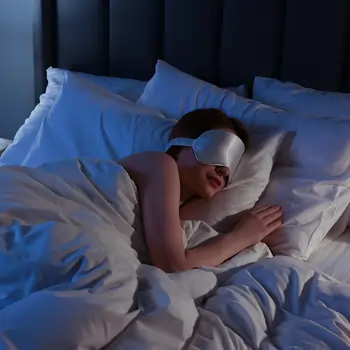5 Effective Breathing Techniques for Sleep
A good night's sleep is crucial for optimal body function, but many find it challenging to achieve.
It’s estimated that around 40 million Americans have trouble falling and staying asleep.
Luckily, there are simple and effective ways to promote deep relaxation and improve your sleep quality. One of the most popular methods is breathing techniques.
Tired of restless nights?
Don’t let insomnia hold you back. Take the first step towards better sleep with LifeMD.


What are Breathing Techniques for Sleep?
Breathing techniques for sleep are designed to help individuals relax their mind and body.
These techniques make it easier to fall asleep while improving the quality of your night’s rest.
Sleep-focused breathing techniques usually help with controlling your breathing to shift the body’s balance from the sympathetic nervous system to the parasympathetic nervous system.
The parasympathetic nervous system is what promotes rest and makes you feel tired.
Activating this nervous system lowers your heart rate and stress levels while relaxing your muscles, and preparing your body for sleep.
The table below outlines the differences between the parasympathetic and sympathetic nervous systems.
Parasympathetic nervous system | Sympathetic nervous system | |
Role | Dominant during resting periods. Prompts relaxation, digestion, and restoration of bodily functions | Prepares the body for action, triggering our fight-or-flight response |
Heart rate | Slows down to signal a time of rest | Accelerates |
Breathing | Becomes deep and regular | Rapid and shallow |
Hormones released | Promotes the release of hormones associated with relaxation, such as serotonin and melatonin | Triggers the release of stress hormones, like cortisol and adrenaline |
Effects on sleep | Facilitates falling asleep and maintaining deeper periods of rest | Can interfere with your ability to fall asleep and stay asleep |
5 Best Breathing Techniques for Better Sleep
4-7-8 technique
This technique offers a simple and powerful method to relax and sleep.
It’s based on an ancient Indian practice that involves a method called pranayama, which emphasizes rhythm and breath control.
By controlling the deep breathing cycle, the 4-7-8 technique helps to slow down the heart rate and encourage relaxation.
Method:
-
Take a relaxing breath in and exhale completely through your mouth, making a whoosh sound.
-
Close your mouth and inhale quietly through your nose, counting silently to four.
-
Hold your breath for a count of seven.
-
Exhale completely through your mouth, making a whoosh sound to a count of eight.
-
This is one breath. Now, inhale again and repeat the cycle three more times for a total of four breaths.
Bhramari pranayama
The Bhramari pranayama technique — also called “bee breath” — is known for its instant calming effects on the mind.
It’s also useful for stress and anxiety relief, making it easier to fall asleep.
When practicing this technique, you’ll make a humming sound while breathing.
The vibration of the humming sound helps to focus the mind, minimizing external distractions and inducing a meditative state.
This sound also has a soothing effect on the brain and nervous system.
Method:
-
Exhale fully through your mouth.
-
Close your mouth and inhale through your nose to a count of four.
-
Hold your breath for a count of four.
-
Exhale through your mouth for a count of eight.
-
Repeat four times.
Diaphragmatic breathing
This technique is also known as belly breathing, and it focuses on engaging the diaphragm, allowing for deeper and more efficient breaths.
Breathing more deeply can enhance relaxation and potentially lead to improved sleep quality.
Method:
-
Exhale fully through your mouth.
-
Close your mouth and inhale through your nose to a count of four.
-
Hold your breath for a count of four.
-
Exhale through your mouth for a count of eight.
-
Repeat four times.
Box method
Box breathing — or square breathing — is a technique used to manage stress and improve concentration.
It’s often used by professionals — like athletes and police officers — to stay calm in high-stress situations. But box breathing has also been found to be beneficial for promoting better sleep.
When practicing this technique, you’ll focus on regulating the nervous system, which distracts the mind from external stressors and helps it to relax.
Method:
-
Exhale fully through your mouth.
-
Close your mouth and inhale through your nose to a count of four.
-
Hold your breath for a count of four.
-
Exhale through your mouth for a count of eight.
-
Repeat four times.
4-4-8 breathing technique
This technique is a variation of the 4-7-8 method and focuses on a longer exhale to promote relaxation and ease you into restful sleep.
It increases parasympathetic activity by extending the exhale, which is key to inducing a restful state. This helps to lower your stress levels and improve your emotional well-being.
Method:
-
Exhale fully through your mouth.
-
Close your mouth and inhale through your nose to a count of four.
-
Hold your breath for a count of four.
-
Exhale through your mouth for a count of eight.
-
Repeat four times.
Tips for Incorporating Breathing Techniques into Your Sleep Routine
Establish pre-sleep rituals
Creating a healthy night-time routine is a great way to incorporate breathing techniques into your bedtime rituals.
This routine could involve turning off electronic devices, dimming your lights, and doing a quiet activity like reading or listening to relaxing music.
The goal of these routines is to signal to your body that it’s time to go to bed. You can incorporate your breathing exercises into any step of this routine.
Choose a comfortable breathing position
Although breathing exercises can be done in any posture, selecting a comfortable position that you can sustain for several minutes may improve relaxation.
Many people find that lying on their back with a small pillow under the knees is quite effective.
Others may find sitting on their bed with their back against the wall more comfortable. You can experiment with different positions to see which one works best.
It’s also important for your sleep environment to be relaxing, so try to ensure that it’s quiet and that you have a comfortable mattress and pillows.
Start with simple techniques
If you're new to breathing exercises, begin with simple techniques such as the 4-7-8 or box methods.
These techniques are easy to remember and can be very effective in promoting relaxation. They also don’t take up a lot of time.
As you gain familiarity and proficiency with breathing techniques, you can integrate more advanced methods into your practice.
Over time, you might find that extending the length of your breathing sessions enhances their soothing effects.
Use guided breathing apps
There are many free and paid apps — like Headspace or Calm — available that offer guided breathing exercises designed to promote sleep.
These can be particularly helpful if you find it difficult to maintain focus or if you're looking for variety in your breathing exercise routine.
Guided breathing apps are also great for beginners who might not know where to start or which methods to try.
Be patient and consistent
Like any new habit, incorporating breathing techniques into your sleep routine may take some time before you see results.
That’s why it’s important to be patient and consistent with your practice, even if you don't notice immediate improvements in your sleep quality.
In most cases, it will take a few weeks of diligent practice before you’ll start noticing the benefits.
Where Can You Learn More About Better Sleep Habits?
If you’re concerned about your sleep habits or want to know more about breathing techniques that promote relaxation, LifeMD is here to help.
LifeMD can connect you to a team of medical professionals who can provide information and guidance on how you can create an optimal sleep environment through healthy habits.
Make your appointment today to get started.
More articles like this
Feel better with LifeMD.
Your doctor is online and ready to see you.
Join LifeMD for seamless, personalized care — combining expert medical guidance, convenient prescriptions, and 24/7 virtual access to urgent and primary care.

Ramelteon
Better Sleep Solutions for You
You may qualify for a prescription to support better, more restful sleep.
Get Started Now
 Medically reviewed and edited by
Medically reviewed and edited by 










